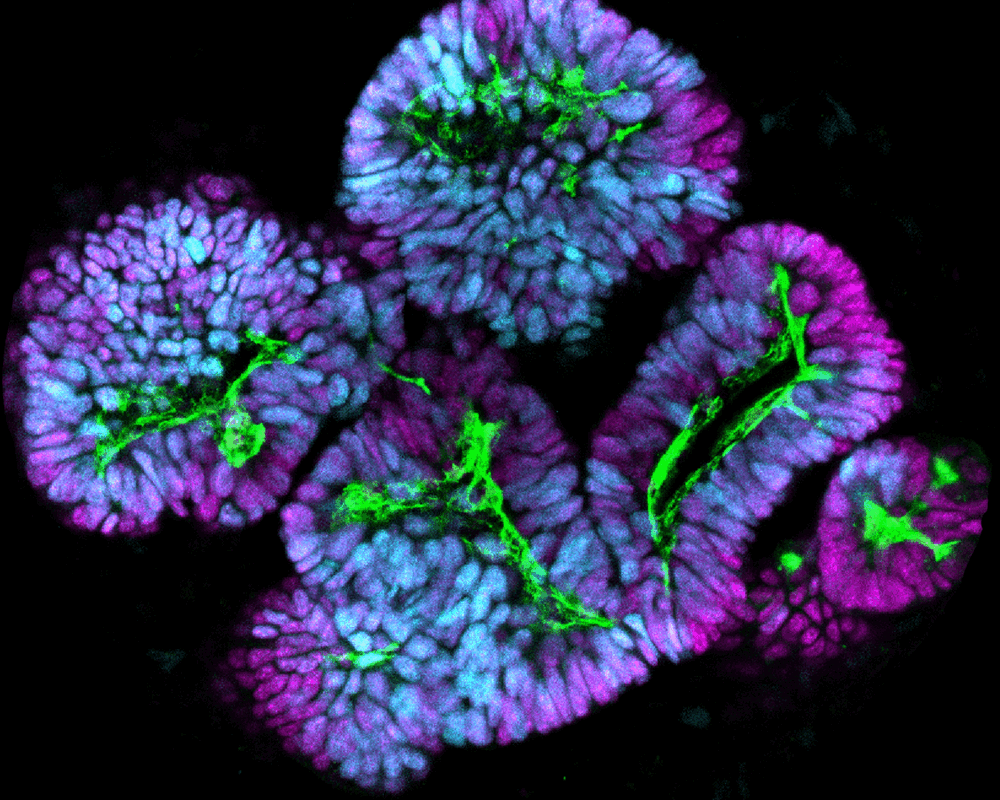
In the lab, it’s easier to grow simple balls of cells than complex asymmetrical structures with two distinct ends—like the one million filtering units, or nephrons, that make up a human kidney. But new research unveils a blueprint that makes it possible to generate specific kidney cell types on demand—cells that hold immense value for preclinical studies of new therapeutics, congenital kidney diseases, and drug-induced nephrotoxicity.
By studying how nephrons form during normal human development, USC Stem Cell scientists have unlocked the process of how cells organize along a longitudinal axis to create nephrons. Each nephron has a “proximal” end that connects to the blood and filters impurities into urine, and a “distal” end that drains the urine into collecting ducts.
The findings appear in a pair of Nature Communications studies, led by two PhD students from the laboratory of Nils Lindström, assistant professor of stem cell biology and regenerative medicine at the Keck School of Medicine of USC.
In the first paper, published August 25, first author MaryAnne Achieng and colleagues used human stem cell-derived organoids—rudimentary lab-grown kidney structures—to uncover the signals that drive the differentiation and organization of different nephron cells.
In organoids containing hundreds of nephron-like structures, the team identified a “switch” that directs precursor cells toward either a proximal or distal identity.
“Our system highlights how precursor cells are not locked into adopting a certain identity or fate, and paves the way for generating nephron cells on demand,” said Achieng, who will join the University of California, San Francisco after completing her PhD at USC.
To form distal nephron cells, which mature into the urine-composition-balancing tubule known as the loop of Henle, the scientists modulated key molecular signals or “pathways” known to drive embryonic development and the differentiation of stem cells into more specialized cell types, among other biological processes. Specifically, they suppressed the cell-to-cell signaling pathway BMP, activated the WNT pathway, and switched on the FGF pathway. If they switched off FGF, the cells reverted to a proximal identity and would eventually start to mature into filtration and absorption structures, including podocytes and early-stage proximal tubules.
In the second paper, published August 30, first author Jack Schnell tackled the challenge of further maturing these proximal tubule cells to behave more like the ones in a human kidney.
Comparing normal human kidney development with organoid proximal tubule cells, the team discovered that the lab-grown versions failed to fully mature because they lacked normal signals that control how the nephron’s proximal-to-distal axis forms, which is essential for well-organized proximal tubules.
They found that nephron cells could be encouraged to adopt a proximal tubule identity by tweaking cell signaling. Researchers then tested the lab-grown proximal tubule cells to see how they would function compared to proximal tubule cells in a human kidney by exposing them to various substances. They found that these lab-grown cells formed organoids that absorbed sugar (dextran) and protein (albumin), and responded to the chemotherapy drug cisplatin by showing drug-induced injury—recapitulating the behavior of human kidneys. Finally, the organoids also produce transporters, which are proteins that move molecules or drugs across membranes and enable a proximal tubule to function—something that has been missing for the field and for the pharmaceutical industry.
“Our proximal tubule-like organoids are powerful tools to study development, congenital disease, injury and physiology,” said Schnell, who will start a position at Ambry Genetics after receiving his PhD from USC.
Lindström added: “Every step we take makes this more complicated, but we are starting to get an idea of how genetic signals control the spatial organization of the early human nephron. This knowledge is fundamental to generating kidney cells and functional nephrons for research and potential therapies.”
About the study
For both papers, Lindström, Achieng, and Schnell are co-authors, along with Connor C. Fausto, Kari Koppitch, Matthew E. Thornton, and Brendan H. Grubbs from USC.
For Achieng’s paper, Réka L. Csipán from USC is also a co-author.
Schnell’s paper includes additional co-authors Zhen Miao from the University of Pennsylvania; and Lola Takhirov, Victoria Wang, Faith De Kuyper, Biao Huang, Megan Schreiber, Pedro Medina, Zhongwei Li, and Junhyong Kim from USC.
Both studies were supported by the Eunice Kennedy Shriver National Institute of Child Health and Human Development T32 Training Grant in Development, Stem Cells, and Regenerative Medicine (grant number T32HD060549). Sequencing and organoid research was performed using funding from the National Institute of Diabetes and Digestive and Kidney Diseases (NIDDK grant number R01DK136802-01), the American Society of Nephrology/United States Department of Health and Human Services KidneyX and renalART, and USC.
Achieng’s study was also supported by Lindström lab funding from the USC Department of Stem Cell Biology and Regenerative Medicine Startup Fund, and the California Institute for Regenerative Medicine (CIRM) training grant (grant number EDUC4-12756).
Schnell’s study also relied on additional funding from the NIDDK (Re)Building a Kidney Opportunity Pool.
No federal funds were used for work related to human tissue.
